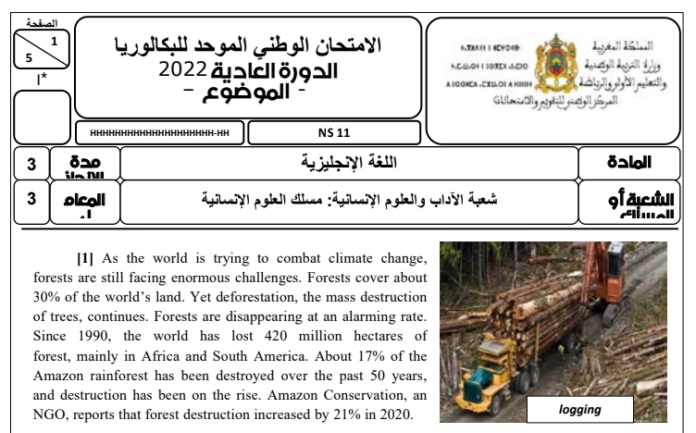The exam’s Comprehension Text
[1] As the world is trying to combat climate change, forests are still facing enormous challenges. Forests cover about 30% of the world’s land. Yet deforestation, the mass destruction of trees, continues. Forests are disappearing at an alarming rate. Since 1990, the world has lost 420 million hectares of forest, mainly in Africa and South America. About 17% of the Amazon rainforest has been destroyed over the past 50 years, and destruction has been on the rise. Amazon Conservation, an NGO, reports that forest destruction increased by 21% in 2020.
[2] Farming and animal grazing activities are responsible for more than half of all deforestation. Natural factors such as fires and floods account for the rest. In Malaysia and Indonesia, forests are cut down to produce palm oil, which can be found in products like shampoo and crisps. Logging provides the world with wood and paper products, but it also destroys countless trees each year. Loggers build roads to access remote forests, and this leads to further deforestation. Forests are also cut as a result of urbanization with more infrastructure installed and homes built.
[3] Deforestation affects the people and animals in areas where trees are cut. Some 250 million people living in forests depend on them for their income. 80% of Earth’s animals live in forests, and many of them are threatened by deforestation. The destruction of forests increases the amount of gases, such as carbon dioxide, which human activities emit. As those gases enter the atmosphere, global warming increases. Tropical trees alone can mitigate the effects of climate change by 23% over the next decade.
[4] Actions are taken to protect forests. Activists are working to fight illegal activities in forests. National Geographic explorer Topher White, for example, has come up with a way to use recycled cell phones to monitor illegal logging. He transforms recycled cell phones into listening devices that can detect logging activity at a great distance. Another example is from Tanzania, where the residents of Kokota have planted more than 2 million trees over a decade to preserve the forest on their small island.
Adapted from: https://www.nationalgeographic.com
National exam | Humanities Stream | Ordinary Session 2022 with answers





